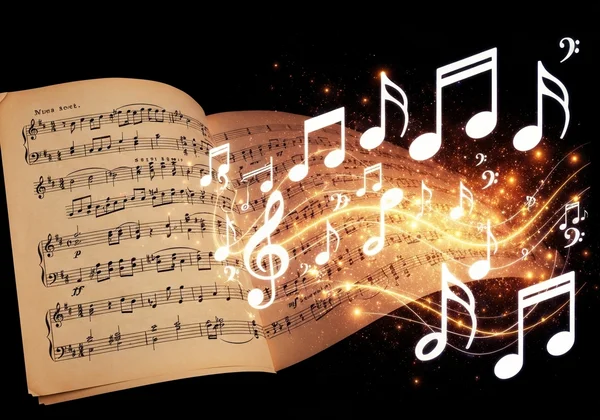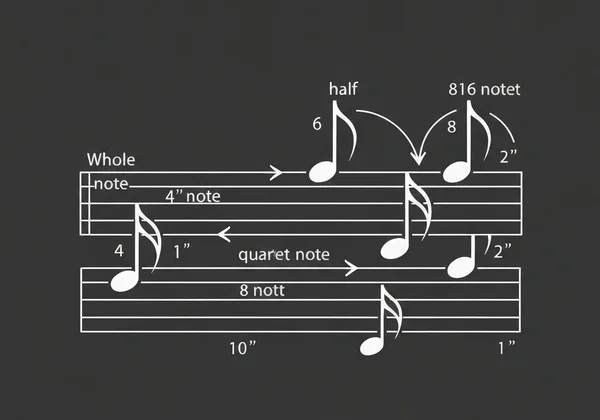How to Read Sheet Music: Learn Music Notation Basics
Ever glanced at a page of music and felt like you were trying to decipher a secret code? You're not alone. For many aspiring musicians, learning to read sheet music seems like a monumental task. But what if you could unlock that language and open a new world of musical expression? This guide is designed to break down the essentials of music notation into simple, manageable steps, empowering you to confidently interpret and even write your own melodies. Are you ready to start your journey to musical literacy?

Learning how to read sheet music is a foundational skill that allows you to play new pieces, understand music theory, and compose your own works. With a little practice, those dots and lines will transform into beautiful sounds. Let's begin by exploring the canvas where all music is written: the staff. For the hands-on exercises ahead, you can get your very own printable staff paper from our homepage.
The Building Blocks: Understanding the Musical Staff
Before you can read notes, you need to understand the framework they live on. This framework is called the musical staff (or stave), and it's the absolute foundation of reading music for beginners. It provides the visual context for pitch—how high or low a note sounds.
Staff Lines, Spaces, and Ledger Lines
The standard musical staff consists of five horizontal lines and the four spaces between them. Both the lines and the spaces are used to place notes. We always count them from the bottom up, so the lowest line is the first line, and the highest is the fifth.
Sometimes, a melody requires notes that are higher or lower than what can fit on the staff. For these, we use ledger lines—short, extra lines drawn above or below the staff to extend its range.

The Alphabet of Music: Identifying Note Names
Music uses the first seven letters of the alphabet: A, B, C, D, E, F, and G. This sequence repeats over and over. As you move up the staff from a line to the next space (or a space to the next line), you advance one letter in the musical alphabet. Once you hit G, the next note up is A, starting the cycle again. The exact pitch of each note is determined by the clef, which we'll cover next.
Practice Tip: Download Your Free Staff Paper
This is the perfect time to start practicing. Theory is great, but applying it is what builds skill. Head over to our website to download some free manuscript paper. Try drawing a staff and labeling the lines and spaces 1 through 5 and 1 through 4, respectively. This simple exercise helps solidify the basic structure in your mind.
Decoding the Clefs: Your Guide to Pitch
A clef is a symbol placed at the very beginning of the staff that assigns a specific pitch to one of the lines. By fixing one "anchor" note, it defines the letter names for all the other lines and spaces. The two most common clefs are the treble and bass clefs, which are essential for music notation basics.
Treble Clef (G Clef): For Higher Voices and Instruments
The treble clef is one of the most recognizable symbols in music. It's also known as the G-clef because its elegant swirl wraps around the second line from the bottom, designating that line as the note G. Instruments that play in higher registers, such as the flute, violin, trumpet, and the right hand of the piano, primarily use the treble clef.
To remember the note names for the lines in treble clef, use the mnemonic: Every Good Boy Does Fine (from bottom to top). For the spaces, just remember the word FACE.
Bass Clef (F Clef): For Lower Voices and Instruments
The bass clef is used for instruments in lower registers, like the cello, bass guitar, trombone, and the left hand of the piano. It's called the F-clef because its two dots surround the fourth line from the bottom, identifying that line as the note F.
A popular mnemonic for the bass clef lines is: Good Boys Do Fine Always. For the spaces, you can use: All Cows Eat Grass.

Exploring Other Clefs: Alto and Tenor (Briefly)
While less common, you might encounter other clefs like the Alto and Tenor clefs, often called C-clefs. These are primarily used by instruments like the viola and cello in their higher ranges. For now, focus on mastering the treble and bass clefs, as they cover the vast majority of music you'll encounter.
The Beat Goes On: Understanding Rhythm and Time
Music isn't just about pitch; it's also about rhythm—the timing and duration of notes. Understanding rhythm is what gives music its pulse and makes you want to tap your foot. This involves learning about note values and time signatures.
Note Values and Rests: Duration in Music
Each note has a specific duration, or value, that tells you how long to hold it. The most common note values are:
- Whole Note: Typically lasts for four beats.
- Half Note: Lasts for two beats (half the duration of a whole note).
- Quarter Note: Lasts for one beat.
- Eighth Note: Lasts for half a beat.
For every note value, there's a corresponding rest of the same duration, which signifies silence.

Time Signatures: The Meter of Music Explained
The time signature appears at the beginning of the music, right after the clef. It looks like a fraction, with one number over another.
- The top number tells you how many beats are in each measure (a measure is a segment of music between two vertical lines on the staff).
- The bottom number tells you which note value gets one beat. A '4' on the bottom means a quarter note gets one beat.
So, the most common time signature, 4/4, means there are four beats per measure, and the quarter note gets one beat.
Exercise: Write Your Own Rhythms on Staff Paper
Now it's time to become a composer! Grab some blank sheet music from our site. Choose a 4/4 time signature and try to fill a few measures with different combinations of quarter notes, half notes, and whole notes. Make sure each measure adds up to exactly four beats. This is a fantastic way to internalize how rhythm is written.
Adding Emotion: Dynamics, Tempo, and Articulation
Once you understand pitch and rhythm, you can start exploring the expressive markings that turn notes on a page into true music. These symbols guide the performer on how to play the notes with feeling.
Dynamics: How Loud or Soft?
Dynamics tell you the volume of the music. You'll see letters like p for piano (soft) and f for forte (loud). You might also see crescendo symbols (<) to gradually get louder and decrescendo symbols (>) to gradually get softer.
Tempo Markings: How Fast or Slow?
Tempo markings, often written in Italian, indicate the speed of the music. Terms like Largo (very slow), Adagio (slow), Allegro (fast), and Presto (very fast) set the overall mood of the piece.
Articulation: Shaping the Sound of Notes
Articulation marks instruct you on how to attack or shape a note. A dot above or below a note means staccato (play it short and detached). A curved line over a series of notes is a slur, meaning you should play them smoothly and connected, which is known as legato.
Your Next Steps in Learning Music Notation
You've taken a significant first step on your journey to musical literacy! Understanding the staff, clefs, notes, rhythm, and expressive markings will open countless doors in your musical life. The key to mastery is consistent practice. Don't just read about it—do it!
Head over to our platform to download and print your free customizable staff paper and start practicing what you've learned today. Write down scales, copy short musical phrases, or compose your own simple melodies. The more you engage with notation, the more natural it will become. Keep exploring, keep creating, and let your musical voice soar!
Frequently Asked Questions About Music Notation
What is staff paper called?
Staff paper is also commonly known as manuscript paper, music paper, or score paper. It's the essential tool for any musician who wants to write, transcribe, or study music by hand.
How many lines are on staff paper?
A standard musical staff has five parallel horizontal lines and four spaces. This five-line system has been the standard for Western music notation for centuries, providing a clear visual guide for pitch.
Where can I get free printable staff paper?
The best place is right here! On our platform, you can instantly generate and download high-quality, free, and customizable staff paper. You can choose from various templates like piano, guitar, or choir, select your clef, and set the paper size to fit your exact needs.
Is learning to read sheet music difficult for beginners?
Like any new language, it takes time and practice, but it's not as difficult as it looks! By breaking it down into small parts—staff, clefs, notes, and rhythm—and practicing regularly, anyone can learn. The key is to be patient and consistent.
What's the best way for a beginner to practice reading music?
The best way is through active engagement. Use blank sheet music to write out scales, simple songs you already know, and rhythm exercises. Try sight-reading very simple pieces of music daily. The more you immerse yourself in the language, the faster you'll become fluent.